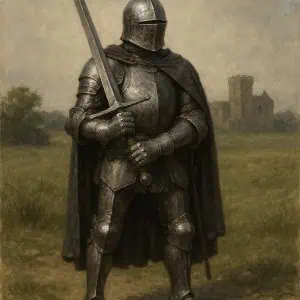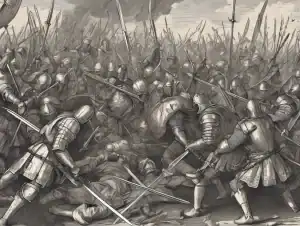The arming sword was one of the most widely used medieval swords in Europe during the High Middle Ages (roughly the 11th to 15th centuries). Favored by knights and soldiers alike, this versatile one-handed sword served as both a primary weapon in battle and a trusted sidearm when paired with a shield. Its popularity extended across centuries, making the arming sword a defining blade of medieval warfare and chivalry.

The name “arming sword” comes from the practice of knights arming themselves for battle, where the sword was an essential part of their military equipment. Typically worn with a knight’s armor and shield, the arming sword was the standard one-handed sword of the High Middle Ages. Unlike heavier two-handed weapons, it was lightweight, versatile, and well-suited for both cutting and thrusting in combat.

History of the Arming Sword
The arming sword of the European High Middle Ages was a straight, double-edged weapon with a single-handed, cruciform hilt. It was typically wielded in one hand, though it could also be used with two hands on occasion.

Medieval swords were often forged from tempered steel and sharpened to a point that could pierce plate armor.

Characteristics of the Arming Sword
The arming sword is a medieval sword that is believed to have originated in France. It’s single-handed and uses a cruciform hilt. Its blade was single-edged, straight, and of moderate length. It had a sharp point and an edge on both sides of the blade which made it difficult to block.

Why the Arming Sword was the Perfect Weapon for the European High Middle Ages
There are many types of medieval swords; some of which were used as tools, others as symbols of power. In Europe during the High Middle Ages, one such type was the arming sword. While not as long or heavy as other medieval swords, it had enough weight to thrust at close range and it was sturdy enough to parry blows from heavier weapons like axes and maces.

How knights Carried Arming Swords into Battle
Medieval swords were not just used in warfare, they were also used in jousting tournaments and other forms of martial arts. They were so important that they became a symbol of one’s nobility. Knights would wear their swords on the right side, opposite to what we are accustomed to today.
This was done to ensure that when they went into battle, it would be clear to all who saw them which side was theirs. Medieval swords had a broad range of designs and lengths.

📜 Frequently Asked Questions: The Arming Sword
Why is it called an arming sword?
The term comes from the practice of knights arming themselves for battle. The arming sword was a standard part of a knight’s military equipment.
When was the arming sword most popular?
The arming sword was most widely used during the High Middle Ages (11th–15th centuries), before being replaced by larger longswords.
Who typically used the arming sword?
Knights and soldiers carried arming swords, often paired with a shield or buckler, making them versatile on the battlefield.
What made the arming sword different from the longsword?
The arming sword was one-handed, lighter, and shorter, while the longsword was a two-handed weapon that emerged later in the medieval period.
How was the arming sword used in combat?
It was effective for both cutting and thrusting, often used in combination with a shield for offense and defense.
What materials were used to make arming swords?
They were forged from high-carbon steel, with hilts often featuring wooden grips wrapped in leather for secure handling.
Are any original arming swords preserved today?
Yes, several authentic arming swords survive in European museums, though most are rare due to centuries of use and decay.





